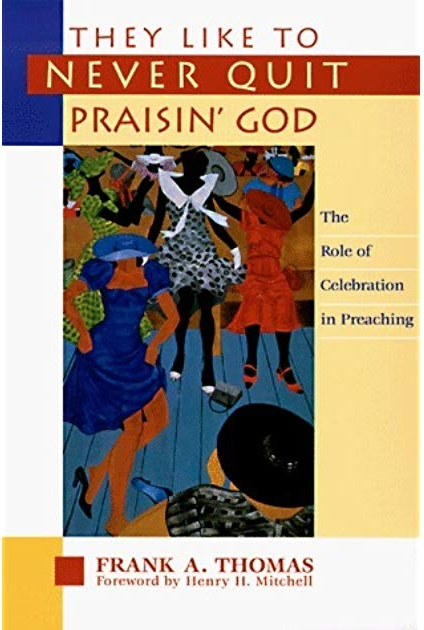They Like to Never Quit Praisin’ God by Frank A. Thomas
by Sarah Garza on Wednesday, September 28, 2016

Book review by Sarah Ingham Garza
Celebration is key to preaching, according to Frank A. Thomas. In They Like to Never Quit Praisin’ God he argues that the celebrative and experiential style of preaching that is found in traditional African American preaching has much to add to the study and practice of homiletics. Thomas offers theological support for the role of celebration in preaching and outlines the characteristics that make up celebratory preaching.
Scripture is the first characteristic of celebratory preaching that Thomas lists. For him, “the Bible is seen as the inspired and dynamic source for understanding the world and the wise guide for life’s decision”. The text serves as the most important source for preaching and Thomas depends on these texts to offer theological support for celebratory preaching. He believes that good news is central to preaching and that the natural response to this good news is, of course, celebration! He summarizes this good news as the understanding “that God through Jesus Christ has forever defeated Satan, evil, and death in all of its forms and manifestations.” This good news is what lies at the heart of Christian scripture, and when it is “received and appropriated,” the “natural response” is celebration.
A second characteristic of celebratory preaching is that it is experiential in nature, as preachers seek to “stir the five senses” so that the congregation may not only hear the stories, but live and experience them. This experience is not only essential for the preacher to create for the listeners, but in order to do so the preacher must experience it first herself. “The goal of the celebrative sermon is for people to experience the assurance of grace, and if the people are going to experience the sermon in delivery, then the preacher must experience it in preparation.” Metaphoric language, tone of voice, and physical movement in presentation all play a part in the preacher’s ability to communicate the experience to their listeners. According to Thomas, “exegesis and rational inquiry are absolutely essential to quality preaching, but when exegesis is opened to include the emotive and intuitive, the preacher is able to generate images that shape and order experience.” It is the process of finding the “intersection” of scripture and “the streets of life” that has the potential for offering an experience that will prompt people to internalize the message, and change because of its impact.
Preachers have a responsibility to create this experience and to facilitate the encounter between life and Scripture, but they are not, and cannot, operate on their own. They are dependent on a power beyond their own, as it is the Holy Spirit that “ultimately shapes and delivers the message through the preacher.” Without this inspiration of the Spirit, preachers are unable to transform their listeners.
A fifth characteristic of celebratory preaching is its structure as one that creates suspense that leads to celebration. This pattern is not unique just to preaching, but is found across generations and genres: “one experiences a situation, there occurs some complication of that situation, and then invariably there is some kind of resolution of the complication.” Sermons seek to resolve the suspense “in light of the gospel”. This resolution of course leads to celebration of the very gospel that offers the resolution.
Thomas presents the performative nature of celebratory preaching as its final characteristic. This means that in preaching, “the word of God must be “embodied” in the total person of the preacher.” Preachers often learn the tradition of celebratory preaching through what amounts to apprenticeship; they watch and listen to others in order to learn by seeing and doing. The performative nature of this type of preaching also allows for audience response and improvisation on the part of the preacher. There is give and take, including immediate feedback for the preacher, so the ‘performance’ becomes a multi-member experience.
Though I truly appreciate the emphasis on celebrating the good news, as this is a vital part of what I believe preaching is intended to share, I do wonder at the limits of focusing solely on it. Thomas opens up room for other emotions in the creation of suspense, as long as it ends with celebration. Does this leave enough room for challenge and conviction when congregations need to hear these messages as well? Can this model of celebratory preaching be taken alongside other models, or is it intended to encompass all others? Overall, I appreciate what the text has to offer and find the reminder to never quit praisin’ God a helpful one.
***
Sarah Garza is in her final year of studies as a Master of Divinity Student at Perkins School of Theology. She is currently serving as a ministry intern at First United Methodist Church in Hurst.
